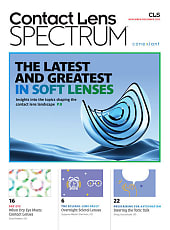Ironically, while putting this issue together, the annual Dry Eye Disease Issue, the Tear Film & Ocular Surface Society (TFOS) Dry Eye Workshop (DEWS) III was released. For US optometrists, a new DEWS report can arguably be likened to a new iPhone. Allow me to elaborate.

High Anticipation
As with each model of the iPhone, each new DEWS report is highly anticipated. No, there isn’t a line of optometrists outside the Tear Film & Ocular Surface Society’s Boston, Massachusetts, headquarters awaiting its release. But news of the availability of the report can prompt the kind of fervor to “click” that accompanies the release of the latest version of iPhone.
Expanded Offerings
Each DEWS report, like the iPhone, offers expanded offerings from its predecessor. For example, the first iPhone included a 2-megapixel camera, sans flash, zoom, or the ability to edit the acquired photos. The latest model, the iPhone 16, includes an ultrawide dual camera system to enable the capture of detailed photos, flash, zoom, the ability to edit photos, and a spatial capture feature that enables acquired photos to appear in 3D.
The first DEWS report was a re-spectable 140 pages. It provided an evidence-based definition of DED, the acknowledgement of DED as a disease, including its classification into 2 subtypes, and a discussion on prevalence, diagnosis, and management.
DEWS III is a robust 637 pages, comprised of 4 sections. Topics in-clude a revised definition of DED, a list of risk factors, subclassifications of the disease, diagnostic tests, and management. The latter, in particular, provides a prescribing algorithm to “offer guidance to clinicians in selecting relevant interventions based on disease etiology that aim to provide targeted management...”
Not in a Silo
As is the case with the iPhone, the TFOS DEWS reports do not exist in a silo. When it comes to communication, for example, we may use a variety of systems: video calls, emails, and text messaging may be equally as useful as the iPhone. In addition to the TFOS DEWS reports, practical guidance regarding DED comes from personal experience with patients, profession-al organizations like the American Academy of Optometry, eyecare-related journals, and industry. In fact, Dr. Lyndon Jones, a DEWS III author and professor; School of Optometry & Vision Science, University of Waterloo, stresses to Optometric Management the importance of not using just one report —even if DEWS has been referred to as the “Dry Eye Bible”—to guide clinical decision-making.
“Clinicians should use DEWS III in conjunction with other data from reputable sources because there is a massive amount of work that has been and is continually being done in this area,” he says.
Translation: Continue learning from many sources, and include the DEWS III report as an important reference among them all. OM



